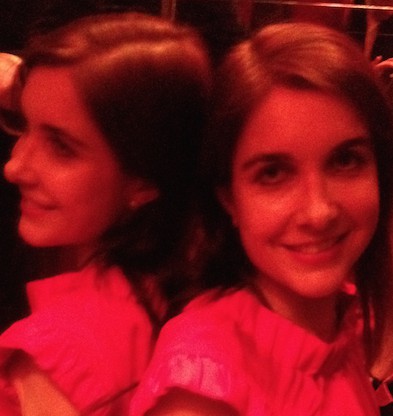Moritz Waldemeyer is an alchemist, bringing the wizardry of cutting-edge technology to the interfaces of design, fashion and music. Creating embedded technology for Hussein Chalayan’s shape-transforming dresses, Bono’s laser-streaking tour jacket and Ron Arad’s Miss Haze and Lolita chandeliers for Swarovski, Waldemeyer fuses engineering knowledge with creative imagination.

Techy Flamboyance
Waldemeyer calls OK Go the ‘quirky kings of geek rock’. He also worked with them in 2007, when he had the ingenious idea, inspired by the slot machines in Las Vegas’ casinos, to turn the band into ‘a moving
 This article appeared in DAMN°23. Order your personal copy.
This article appeared in DAMN°23. Order your personal copy.
The fact that Waldemeyer is fêted by the art, design, music and fashion worlds has happened way beyond even his wildest dreams. Born in East Germany 35 years ago, he grew up feeling deprived, frustrated, restrained and imprisoned. ‘I always hated East Germany and thought that if I could escape and leave, I would,’ he declares. ‘Even now that it’s changed, I would never go back. When I was growing up, we could watch western TV; I had friends in the West but couldn’t travel. We were locked in. But in my family there were a lot of art- ists. In a way, the [GDR] regime enabled this bohemian community to be created because there were no com- mercial pressures on artists to produce anything com- mercially viable. It’s a paradox because, with the crazy system in place, artists had a liberal lifestyle.’
Waldemeyer moved to London in 1995. His education is more geeky and brainy than arty. He studied Euro- pean Business Administration at Middlesex University and has a Master of Science in Mechatronics from King’s College, London. Mechatronics is the synergistic inte- gration of mechanics, electronics, embedded control and IT in the design and realisation of intelligent prod- ucts; it’s mechanical engineering for the 21st century. The training led Waldemeyer to become a research sci- entist at Philips Research Lab, exploring how technol- ogy could be developed for clothing, home entertain- ment and lighting, and the implications for design and functionality.
Motion Sensitive
Waldemeyer’s break was in 2003, when he became a visiting tutor at the Royal College of Arts’ design prod- ucts course. Ron Arad was head of the department. ‘It was a lucky coincidence that Ron Arad had just beencontacted to make a chandelier for Swarovski,’ Wal- demeyer notes. First he collaborated with Arad on the Lolita chandelier, which displays text messages using LEDs embedded in the individual crystals, and then on Miss Haze, which allows the user to project an image of their own design onto the crystals via a palm computer and Bluetooth connection. Subsequent chandelier projects include working with Yves Béhar on Voyage, with motion-sensitive LEDs embedded into the structure that are triggered to light up as people walk past, and with Fredrikson Stallard on Pandora, both for Swarovski, and on Twilight, commissioned by Microsoft’s Zune brand. Indeed, Waldemeyer has worked with the top names in the business, includ- ing Zaha Hadid on her Z Island kitchen. Thanks to a touch-sensitive panel made of DuPontTMCorian®, the user can browse the Internet, watch television, listen to music or create a desired ambience using coloured lighting and aromatherapy.
Laser Dancing Cage
To date, Waldemeyer’s favourite project is the two Airborne video dresses for Chalayan’s autumn/winter 2007 collections, with Swarovski crystals and 15,000 ickering LEDs embedded beneath the white fabric. The brief, given only four weeks before the Paris cat- walk show, was to create video sequences that could be displayed across the entire surface. ‘It was insanity that the brief had be made in that time-frame,’ says Walde- meyer. ‘But it hasn’t been topped by any other project.’In one video sequence, a rose blooms and then retracts. The other shows the silhouettes of sharks in the sea. ‘The effect is mesmerising in its ambiguity,’ continues Waldemeyer. ‘The loose white fabric covering the LED’s blurs and distorts the images so that they seem to pul- sate in and out of existence.’
Other recent projects include a commission by Wall- paper* magazine to design an object around the home disco theme. For this, Waldemeyer came up with an- other sci- fantasy: a 1960s-inspired simple white cof- fee table that can transform into a virtual laser dancing cage, with vertical lasers shooting up to the ceiling, at night. He is also currently collaborating with the fash- ion show producer Alex de Betak on LED bulbs that can be screwed into 240V sockets and working on a commission for Bombay Sapphire. ‘But I don’t like talking about things before they happen; it feels like bad karma,’ he insists. Yet Waldemeyer zealously com- municates about projects once they’re completed. His Internet site is exhaustive. Besides detailed descriptions of briefs, it has a blogspot dating back to May 2006. One posting from October is a Style.com photo of him posing with Paul Cocksedge and Ambra Medda. He in- vites visitors to ‘follow me on Twitter’. He’s having the time of his life and isn’t shy of broadcasting it. ‘If some- body had said to me 10 years ago: “You’ll do a jacket for Bono, then a jacket for Rihanna, and a guitar for Fendi”, I would never have imagined it,’ Waldemeyer exclaims. ‘Nobody would have imagined such a thing. I have trouble even explaining it. Everything collects on my computer screen, then you see the madness of it all. If you have a laptop, it gives you all this amazing creative power.’


